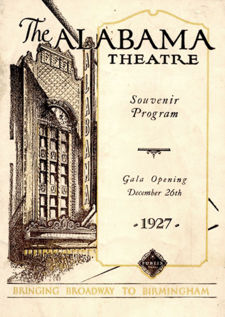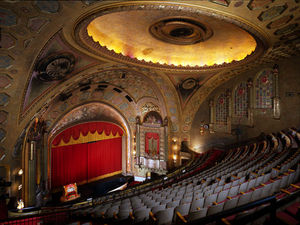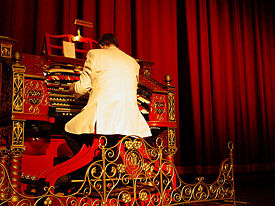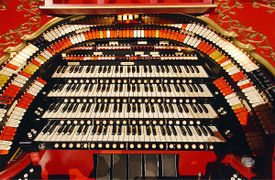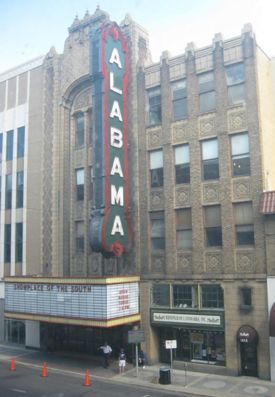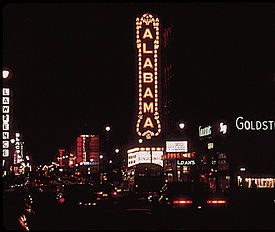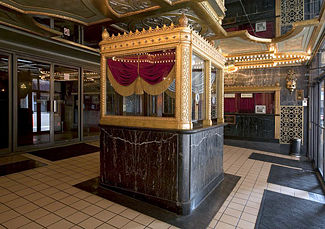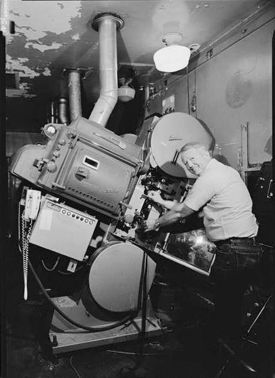Alabama Theatre: Difference between revisions
| Line 56: | Line 56: | ||
The front façade of the Alabama was intended as a tribute to New York's Paramount Theatre. It is composed of a monumental arch inset with terra-cotta detailing and surrounded by patterned brick. The elaborate interior, a highly-theatrical themed environment drawing liberally from many styles of architecture, is most heavily influenced by the Hispano-Moresque style. Materials used included marbles from Belgium, France and Italy, granite from Minnesota, terra-cotta fabricated in New York, and woodwork from Wisconsin, Florida and Louisiana. Interior furnishings include original paintings in oil and gilt decorative objects. Much of the plaster ornament is gilt or marbled. Elaborate light fixtures decorate the auditorium and lobby. | The front façade of the Alabama was intended as a tribute to New York's Paramount Theatre. It is composed of a monumental arch inset with terra-cotta detailing and surrounded by patterned brick. The elaborate interior, a highly-theatrical themed environment drawing liberally from many styles of architecture, is most heavily influenced by the Hispano-Moresque style. Materials used included marbles from Belgium, France and Italy, granite from Minnesota, terra-cotta fabricated in New York, and woodwork from Wisconsin, Florida and Louisiana. Interior furnishings include original paintings in oil and gilt decorative objects. Much of the plaster ornament is gilt or marbled. Elaborate light fixtures decorate the auditorium and lobby. | ||
Like its predecessor, the [[Ritz Theatre]], the Alabama was one of the first air-conditioned buildings in Alabama. A cooling plant supplied by the Brunswick-Kroeschell Company pulled ambient air through grilles beneath the orchestra seats so it could be "washed, dried and then forced down through high overhead ducts". | |||
===Exterior signage=== | ===Exterior signage=== | ||
Revision as of 17:31, 5 March 2017
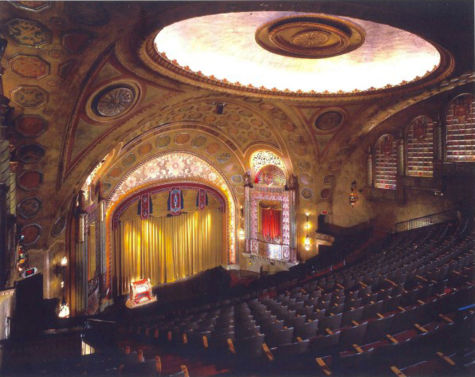
The Alabama Theatre, is a 2,200 seat "movie palace" opened by Paramount Studios in 1927 at 1817 3rd Avenue North in downtown Birmingham's "Theater District".
Paramount constructed the theater as its first-run showplace, overtaking the Strand and Galax in that role. It was constructed to showcase the silent films of the era, with staging for live performances which Publix produced to accompany feature screenings at its largest theaters. A feature of the house is the "Mighty Wurlitzer" theater organ, the console of which can be raised to stage level for recitals or lowered out of sight to accompany films.
Now painstakingly restored, the Alabama is operated by Birmingham Landmarks, a non-profit corporation founded by Cecil Whitmire. The Alabama hosts numerous live concerts and classic movie screenings, as well as weddings and private events throughout the year.
History
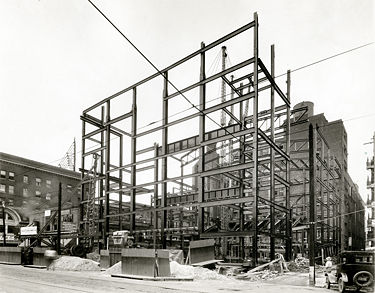
The Alabama was built by Paramount Studio's Publix Theater division as an opulent "movie palace" for screening silent films. It is one of two extant theaters, along with Knoxville's Tennessee Theatre (1928), known to have been designed by the Chicago architecture firm of Graven and Mayger. Arthur G. Larson was the architect responsible for the design. Construction plans for the Alabama were announced in 1926, but ground breaking was delayed until April 1, 1927.
The theater eclipsed the year-old Ritz Theatre, which seated 2,000, as the largest in the city, and replaced the Strand Theatre as the primary outlet for Paramount offerings. An opening preview for invited guests was held, as scheduled, on Christmas Day, 1927, while the first feature, The Spotlight, starring Esther Rawlson and Neil Hamilton, was screened on on December 26. Paramount President Adolph Zukor proclaimed it "The Showplace of the South", an appellation that soon appeared in gilt letters under the marquee.
At its opening, the theater was managed by Sidney Dannenberg, assisted by Steven Barutio and advertising promoter Larry Cowen. Feature film screenings were accompanied by live stage acts produced by Publix' team of John Murray Anderson, Frank Cambria, and Jack Partington. Ralph Pollack conducted the stage band, while Bruce Brummit led the pit orchestra and Joe Alexander manned the Wurlitzer organ.
Loveman's fire
In 1934, the original Loveman's department store next door, a wooden frame building built in 1899, burned to the ground. Thanks to a three foot thick firewall on that side of the Alabama, the theatre was unharmed aside from some minor smoke damage, mainly around air vents in the auditorium. (These smoke stains would remain until the 1998 theatre restoration.)
Decline and Re-opening
The decline of downtown Birmingham through the 1960's and 1970's saw the closing of most of the downtown's movie theatres. In 1981, Plitt Theatres of Chicago closed the Alabama and sold it to Cobb Theatres of Birmingham. Cobb attempted to reopen the Alabama several times, but was unsuccessful. Cobb eventually sold the Alabama to Costa and Head, a developer working to revitalize the downtown area. Costa and Head initiated series of classic movies at the Alabama with some success, but ultimately filed for bankruptcy in 1986.
The Alabama Chapter of the American Theatre Organ Society (ATOS) had been maintaining the Alabama's organ since in the 1970's. They sought permission to remove the organ from the Alabama to save it, but Costa and Head's creditors deemed it the single most valuable item in the building and forbid its removal. In response the Alabama Chapter of ATOS began a fund-raising effort to buy the Alabama, which, with a loan from Citizens Federal Savings Bank, was successful. In 1987, Birmingham Landmarks, Inc. was formed to own and operate the Alabama rather than ATOS. The theatre was renamed the Alabama Theatre for the Performing Arts shortly thereafter.
Landmark status
On December 13, 1979, the Alabama Theatre was added to the National Register of Historic Places. In 1993 the Alabama was designated the "official state historic theatre" by the Alabama legislature. [1] In 1998, the Alabama underwent a complete cleaning and restoration including the seating, carpet and drapes. Smoke stains from the Loveman's fire, visible in the photograph at right, were carefully cleaned and refinished. New York's Evergreene Studios restored the plaster finishes, stenciling and gilding as part of the $1.5 million project.
Birmingham Landmarks continues to operate the Alabama. The group purchased the adjacent Goldstein building in 1992. The Lyric Theatre, a 1914 vaudeville theatre located across the street from the Alabama, was donated to them in 1993.
In 2008 the Alabama Theatre expanded its special-event facilities by opening the Hill Arts Center in the Goldstein building. The new center, accessible directly from the theater, features a 3,000 square-foot ballroom as well as a catering kitchen and two public lobbies.
Managers
- Sidney Dannenberg, 1927-
- Francis Falkenburg, 1936-1950
- Norris Hadaway, 1950-1956
- Mack Russell, 1956-1958
- Cecil McGlohon, 1958-?
- Gary Tucker, 1972-1977
- Cecil Whitmire, 1987-2010
- Brant Beene, 2010-present
Mighty Wurlitzer Theatre Organ
In order to provide music and sound effects for silent films, the Alabama was outfitted with a 4 manual, 20-rank Crawford Special-Publix One Mighty Wurlitzer theater organ from the Rudolph Wurlitzer Company of North Tonawanda, New York to the specifications of Jesse Crawford.
Dubbed "Big Bertha", or simply "The Mighty Wurlitzer", it is one of 17 of its type ever built, and one of only three still installed in their original sites (The Denver Paramount and The Seattle Paramount have their original Publix 1's). The organ console is mounted on a screw lift that can bring it up to stage level or lower it out of sight to orchestra-floor level. Since its debut, Big Bertha has been expanded to 32 ranks and has seen the addition of multiple percussive and other mechanical effects.
The Alabama's original organist was Joe Alexander. From the 1936 to 1955, the primary house organist was Stanleigh Malotte. When the Alabama began its classic movie series under Costa and Head in the mid-1980's, Cecil Whitmire became the house organist, a position he continued to hold until his retirement as organist in 2007. Currently, Gary W. Jones is the House Organist.
Architecture
The front façade of the Alabama was intended as a tribute to New York's Paramount Theatre. It is composed of a monumental arch inset with terra-cotta detailing and surrounded by patterned brick. The elaborate interior, a highly-theatrical themed environment drawing liberally from many styles of architecture, is most heavily influenced by the Hispano-Moresque style. Materials used included marbles from Belgium, France and Italy, granite from Minnesota, terra-cotta fabricated in New York, and woodwork from Wisconsin, Florida and Louisiana. Interior furnishings include original paintings in oil and gilt decorative objects. Much of the plaster ornament is gilt or marbled. Elaborate light fixtures decorate the auditorium and lobby.
Like its predecessor, the Ritz Theatre, the Alabama was one of the first air-conditioned buildings in Alabama. A cooling plant supplied by the Brunswick-Kroeschell Company pulled ambient air through grilles beneath the orchestra seats so it could be "washed, dried and then forced down through high overhead ducts".
Exterior signage
The Alabama Theatre originally featured two, identical, multi-story tall vertical signs spelling out "Alabama," one above the entrance on 3rd Avenue North and the other on the back of the theater along 18th Street. Both signs were 60 feet tall by 12 feet wide with 4½-foot-tall letters illuminated by 2,338 lamps.
In 1957, the sign on 3rd Avenue was taken down and reworked "to give new display effects." It is unknown precisely when the sign on 18th Street was permanently removed.
The Alabama's marquee, used to advertise the current and upcoming shows, hangs between the entrance and the vertical sign on 3rd Avenue. The original 12-foot tall by 35-foot wide marquee projected 12 feet over the sidewalk and was very ornate, featuring hundreds of individual incandescent light bulbs. It was replaced by a much simpler marquee in 1960, featuring fluorescent lighting that makes it brighter and easier to maintain. It features two strips of chasing bulbs on red backgrounds, one at the top and one at the bottom, both wrapping around the entire marquee.
Lobby areas
Patrons enter the Alabama through its ticket lobby, featuring a small, two-person ticket booth in the center and two sets of decorative mirror designs surrounded by lights. On the west wall is a larger ticket booth which is used for large, reserved seat events. This is the original location of the theatre concession stand.
Upon purchasing their tickets, patrons proceed through the doors into the Hall of Mirrors. This area is three stories tall, with the upper two stories and ceiling covered in mirrored areas. Hanging from the center of the ceiling is a large, three dimensional, star-shaped chandelier made of strings of glass beads. The area also features a staircase up to the mezzanine.
Straight ahead from the Hall of Mirrors, after passing under a "bridge" area where the current concession stand is located, is the main lobby. It is also three stories tall and features a large chandelier and gold-leafed ceiling. Here the main staircase goes up to the mezzanine, while another staircase descends under it to the lounge, where the main restrooms are located. An additional pair of restrooms are located under the second balcony.
Auditorium
The auditorium is five stories tall at its highest point and the brown plaster walls and ceiling are decorated predominantly in red and green. The ceiling features several lit domes, the largest at the top of the ceiling. Additional domes are found at the rear of the balcony at the projection booth and under the main balcony above the mezzanine and main floor. All domes, the proscenium arch around the stage, the front of the organ pipe chambers, and other areas are lit with red, blue, and amber light bulbs. Each color of bulb can be individually dimmed to provide a variety of colors in these areas.
The auditorium features three seating levels: the main floor, the mezzanine, and the balcony. The balcony is further divided by level walkways into the dress circle (the first three rows), the first balcony, and the second balcony. The final row of the balcony is about two stories above the first row and 180 feet from the movie screen.
Projection room
The theatre's projection room, located behind the top-most level of the auditorium, above the lobbies, originally housed four massive carbon arc lamp projectors and at least two carbon arc lamp spotlights. The number of projectors was later reduced to two. The projection room features its own bathroom and access to both the roof and theatre attic, from which the light bulbs for the auditorium domes are changed.
Recurring events
The Alabama has been home to many recurring events of which Birmingham residents have fond memories.
Mickey Mouse Club
One of the things the Alabama was known for in its early days was its Mickey Mouse Club, which was formed in 1933. Meetings were held every Saturday, where the children would perform for each other, watch Mickey Mouse cartoons, and participate in other activities. The Club also sponsored food and toy drives for the underprivileged. By 1935, the Club had over 7,000 members, making it the biggest Mickey Mouse Club in the world. Membership eventually peaked at over 18,000 before the Club closed almost ten years after it was formed.
Miss Alabama Pageant
Another regular event at the Alabama was the Miss Alabama pageant. From 1935 to 1948, the rules of the Miss America pageant allowed multiple contestants per state. The Alabama Theatre hosted the Miss Birmingham pageant in those years. When the rules were changed in 1949, the Alabama became host to the Miss Alabama pageant and continued to do so through 1966.
Phantom of the Opera
In 1979, the Alabama Chapter of ATOS held their first showing of the silent movie The Phantom of the Opera, a 1925 film starring Lon Chaney. Accompaning the film on the Mighty Wurlitzer organ was Tom Helms, who wrote his own score for the movie. The movie and Helms have been back every year since then except 1981, when he performed it in Knoxville and New Orleans. The show usually takes place on the Saturday before Halloween.
Christmas at the Alabama
In the late 1980s, Birmingham Landmarks started an annual Christmas show. It was divided into two acts. One act told the story of Jesus' birth, narrated straight from the Books of Matthew and Luke and interspersed with performances of traditional Christmas hymns and inspirational songs. The second act was of a more secular nature, the storyline being of a child wishing for snow on Christmas in Birmingham — an unlikely event. The show generally closed with his or her wish coming true and Santa leading the entire audience and cast singing "White Christmas" while thousands of white Christmas tree lights lit the auditorium. Birmingham Landmarks ceased production on the show in the mid-1990s.
Trivia
- The Alabama had 2,500 seats when it first opened in 1927. Later renovations replaced the seats on the main floor with larger ones, reducing the seat count to 2,200. (Source: Showplace of the South flyer, Birmingham Landmarks, 1991)
- The Alabama's 22' x 40' screen is the largest in the state.
- For many years, the street address of the Alabama was mistakenly thought by the owners to be 1811 3rd Avenue North. Around 1991, Birmingham Landmarks discovered the error and corrected it to 1817. Street number 1811 belongs to one of the store fronts a few doors down from the Alabama.
- The theater is rumored to be haunted by one or more ghosts.
References
- "Publix' New Birmingham Theatre Holds Formal Opening" (January 14, 1928) Motion Picture News
- "Sign of the Times" (October 25, 1957) Birmingham Post-Herald
- Weaver, Emmett. "Alabama's Marquee Will Shed New Light" (May 12, 1960) Birmingham Post-Herald
- Satterfield, Carolyn Green (1976) Historic Sites of Jefferson County, Alabama. Birmingham: Jefferson County Historical Commission/Gray Printing Company
- Whitmire, Cecil and Jeannie Hanks (2002) The Alabama Theatre: Showplace of the South. Birmingham Landmarks ISBN 0310975124
- "Alabama Theatre" (April 27, 2006) Wikipedia - accessed April 27, 2006
- "Phantom of Alabama Theatre makes the occasional cameo." (October 30, 2006) The Birmingham News
See also
External links
- Alabama Theatre official website
- Alabama Theatre photographs and clippings at the Birmingham Public Library archives.
- Alabama Theatre photographs and drawings at the Historic American Buildings Survey.
- Showplaces of the South at Birmingham Rewound
- Alabama Historic Theatre at the Alabama Department of Archives & History
- Alabama Theatre Organ website
